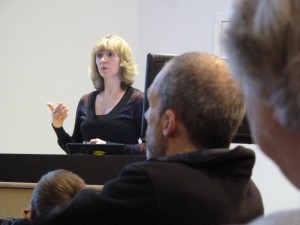Southeast residents show savvy after large earthquake
February 7, 2013

Ned Rozell
2/07/2013
Around midnight on January 4, Kathleen Brandt felt an earthquake at her home in Sitka. As framed pictures trembled and then fell from the walls, she started counting.
“I got to 22 seconds before the shaking stopped,” Brandt said. The 45-year resident of this historic Southeast community told her earthquake story following a recent community presentation there by Natalia Ruppert. Ruppert is a seismologist with the Geophysical Institute’s Alaska Earthquake Information Center. Jim Baichtal of the U.S. Forest Service, who lives in Thorne Bay, invited Ruppert down to Southeast to speak to locals who wanted answers about the shaking.
Following two meetings in Craig and Sitka during which Ruppert answered questions about the large earthquake and weeks of aftershocks, Southeast residents shared a few stories that showed their tsunami savvy.
In the middle of that dark January evening, Brandt rousted her sleeping husband Harvey. She did so because she remembered a fall visit from a scientist who recommended moving to high ground after an earthquake lasting for 20 seconds or more. The Brandts pulled on their rubber boots and drove to the clubhouse at nearby Sea Mountain Golf Course, about 60 feet above sea level.
There, they waited out a possible tsunami with other Sitka residents who had left their homes for higher ground. Some had heard the siren activated by Fire Chief Dave Miller after a magnitude 7.5 earthquake had torn the sea floor west of Prince of Wales Island. Others, like Brandt, moved before they heard the siren because they knew it was the right thing to do to avoid the rising water of an earthquake-generated tsunami.
Though scientists at the West Coast and Alaska Tsunami Warning Center issued an official tsunami warning after the January 4 earthquake, located 80 miles offshore of Prince of Wales Island, no tsunami occurred. Why not?
There was no noticeable tsunami from the earthquake or the aftershocks that followed because the earthquake was a strike-slip, which features side-to-side motion on a fault in Earth’s crust. A strike-slip doesn’t cause upward thrust of the sea floor that displaces water and shoves it toward shorelines. But the January 4 earthquake was so large that officials couldn’t rule out tsunamis caused by unpredictable landslides into the ocean (such was the case when an earthquake shook a mountainside into Lituya Bay in 1958) or causes steep, silty underwater slopes to collapse (as happened in 1964 in both Seward and Valdez).
“Anytime there’s an offshore earthquake of that size, a tsunami warning makes sense,” said State Seismologist Mike West.
Like many people in the small community of Craig, Josh Andrews was in bed around midnight on January 4 when he heard rumbling and felt shaking. The principal of Craig High School remembered feeling a magnitude 7.7 earthquake in the fall that had an epicenter beneath Haida Gwai, islands in Canada about 150 miles south of Craig.
That memory sprung him into action when he felt the 7.5 earthquake. He and his wife got out of bed, dressed, and woke their two kids and an exchange student living with them. They called the family dog and fit most of the living creatures into their car.
“We left the chickens to fend for themselves,” Andrews said.
Andrews took his family to his preplanned evacuation center, the city pool in Craig, about 45 feet above sea level. He brought his family home about one hour later when he received an all-clear Twitter message from a Craig emergency manager.
Unlike in Sitka, there was no siren in Craig (it was broken at the time). Andrews got out of bed and moving because he remembered the jolt of the Haida Gwai earthquake and a basketball from the 2011 Japan tsunami that washed up on Prince of Wales Island.
“I’m not embarrassed that I left my home,” Andrews said. “There’s no downside to moving.”
Since the late 1970s, the University of Alaska Fairbanks' Geophysical Institute has provided this column free in cooperation with the UAF research community. Ned Rozell is a science writer for the Geophysical Institute.


